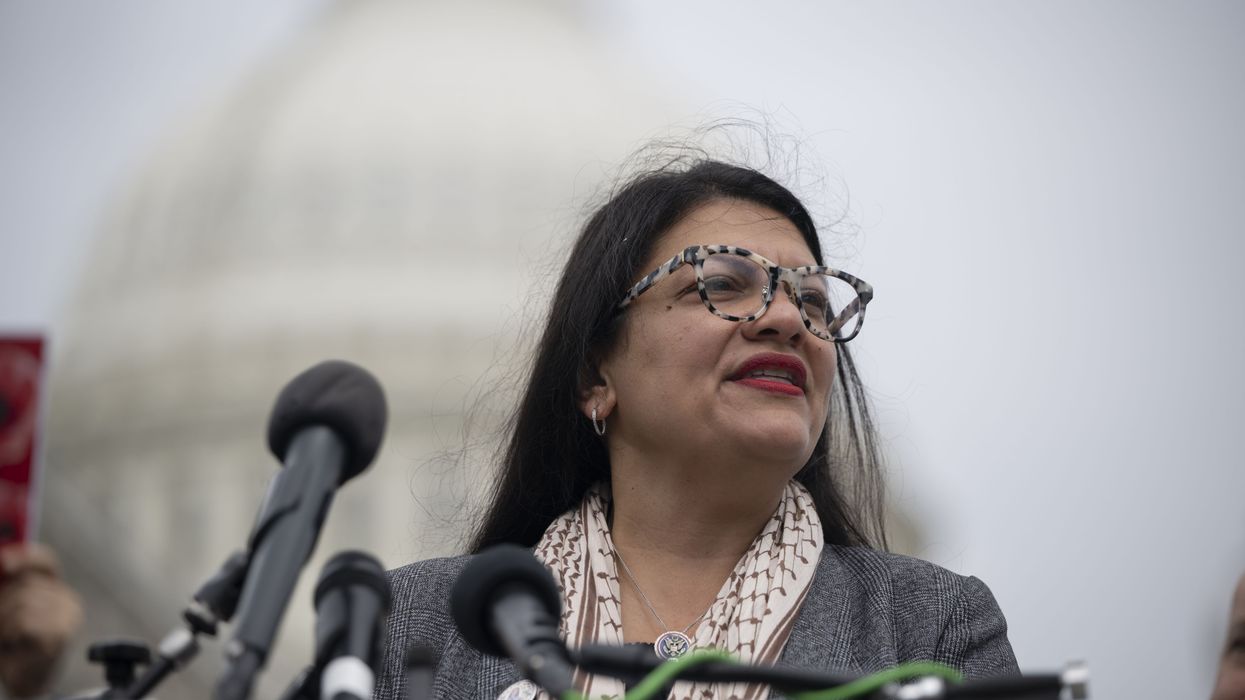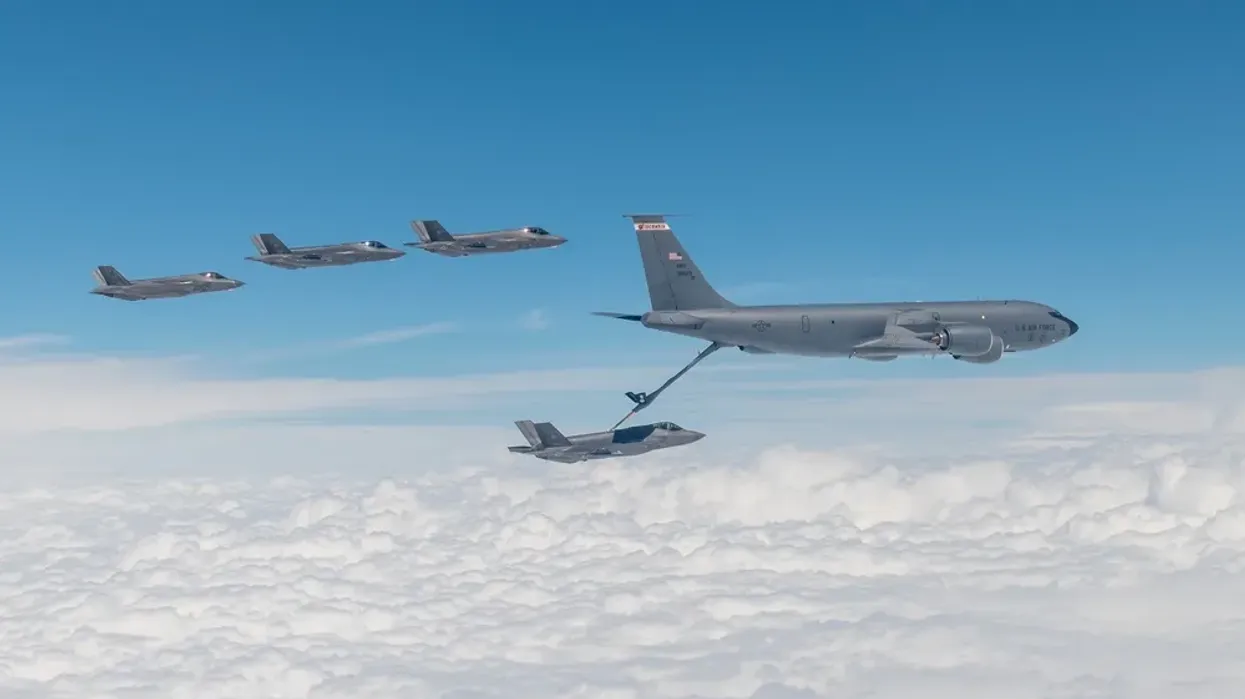January, 06 2009, 04:05pm EDT
The Blame Game in Gaza
Erasing Israeli actions to fault only Hamas
WASHINGTON
The Israeli attacks in the Gaza
Strip that began in late December have reportedly killed over 500
Palestinians, many of them civilians and children. As is often the
case, U.S. corporate media's presentation of the events leading up to
this dramatic escalation in violence have laid the blame for the
violence mostly with Hamas, whose rocket attacks on Israel are often
cited as the cause for the current Israeli attacks.
In many media discussions about the events that led to the fighting,
emphasis is placed on Hamas' decision in late December to allow a
cease-fire agreement with Israel to expire, or the group's failure to
adequately suppress rocket attacks into Israel during the cease-fire.
A USA Today timeline (1/5/09)
explained, "In November, the truce frays as Hamas rockets continue to
land in Israel, which closes several border crossings and kills
militants building tunnels Hamas was using to smuggle weapons and other
goods into Gaza." On NBC Nightly News
(12/27/08), Martin Fletcher explained that "a six-month truce ended
this week and Palestinians fired rockets into Israel, as many as 60 a
day. Israeli leaders said enough is enough."
A Washington Post editorial (12/28/08) announced that Hamas "invited the conflict by ending a six-month-old ceasefire," while Post columnist Richard Cohen (1/6/09) was much blunter: "It took no genius to see the imminence of war. It takes real stupidity to blame it on Israel."
The Dallas Morning News (12/30/08)
agreed emphatically in an editorial titled, "Blood on Hamas' Hands":
"The pictures of the civilian victims of Israeli airstrikes-especially
children-are heart-rending. But let's keep straight whose fault this
tragedy is: Hamas, the fanatical Islamists who rule Gaza and who have
used the land as a launching pad for firing rockets into Israel."
The New York Times' December 28
lead declared, "The Israeli Air Force on Saturday launched a massive
attack on Hamas targets throughout Gaza in retaliation for the recent
heavy rocket fire from the area." The next day, Times reporter Stephen Farrell asked (12/29/08),
"Why did Hamas end its six-month cease-fire on December 19?" He argued
that the "rejectionist credo" of Hamas made this step all but
inevitable.
These accounts fail on several grounds. For starters, the cease-fire
agreement from June through mid-December was credited by many for
ratcheting down the violence-- rocket fire into Israel dropped
significantly and claimed no Israeli lives during the truce. (Prior to
that, rocket and mortar attacks since the Israeli withdrawal from Gaza
in late 2005 had killed 10 Israelis-theisraelproject.org.)
After the cease-fire expired, rocket attacks increased, though no
Israelis were killed until after the Israeli attacks were launched;
four have been killed since then (Agence France-Presse, 1/6/09).
Interestingly, as the truce expired, the New York Times published an article (12/19/08)
that began with a typical corporate media formulation-- Palestinians
are attacking, Israel is retaliating-- before noting that Hamas was
"largely successful" in curtailing rocket fire into Israel: "Hamas
imposed its will and even imprisoned some of those who were firing
rockets. Israeli and United Nations figures show that while more than
300 rockets were fired into Israel in May, 10 to 20 were fired in July,
depending on who was counting and whether mortar rounds were included.
In August, 10 to 30 were fired, and in September, 5 to 10."
The Times article, by Ethan Bronner, noted that what Hamas expected in return from the Israelis never arrived:
But the goods shipments, while up some 25 to 30
percent and including a mix of more items, never began to approach what
Hamas thought it was going to get: a return to the 500 to 600
truckloads delivered daily before the closing, including appliances,
construction materials and other goods essential for life beyond mere
survival. Instead, the number of trucks increased to around 90 from
around 70.
Bronner also added that "Israeli forces continued to attack Hamas and
other militants in the West Bank, prompting Palestinian militants in
Gaza to fire rockets," which produced Hamas response attacks. The Times continued:
While this back-and-forth did not topple the
agreement, Israel's decision in early November to destroy a tunnel
Hamas had been digging near the border drove the cycle of violence to a
much higher level. Israel says the tunnel could have been dug only for
the purpose of trying to seize a soldier, like Cpl. Gilad Shalit, the
Israeli held by Hamas for the past two and a half years. Israel's
attack on the tunnel killed six Hamas militants, and each side has
stepped up attacks since.
This straightforward recitation of events is rarely heard in much of
the rest of the media coverage of the violence in Gaza-including in the
Times, since Israel began its full-scale assault. But for many consumers of U.S. media, history is made irrelevant; a Time magazine piece (1/12/09) began:
Two sounds dominate the lives of Israelis
living near Gaza: the wail of a siren and, 25 seconds later, the
whistling screech of an incoming rocket fired by the Palestinian
militant group Hamas. That gives Israeli families just enough time to
dive for cover-even as they pray the rocket will miss.
At 11:30 a.m. on December 27, a new sound filled the azure
Mediterranean sky: the rolling boom of Israeli bombs and missiles
slamming into Gaza.
Israeli airstrikes in Gaza are anything but "new," but presenting them
as such-and pairing that presentation with an Israeli family sheltered
against an incoming Hamas rocket-gives a wildly misleading impression
of a conflict where the deaths and suffering are overwhelmingly on the
Palestinian side.
FAIR, the national media watch group, has been offering well-documented criticism of media bias and censorship since 1986. We work to invigorate the First Amendment by advocating for greater diversity in the press and by scrutinizing media practices that marginalize public interest, minority and dissenting viewpoints.
LATEST NEWS
Trump Tariffs Have Cost Average US Family Nearly $1,200 So Far
"The president’s tax on American families is simply making things more expensive.”
Dec 11, 2025
As President Donald Trump persistently claims the economy is working for Americans, Democrats in the US House and Senate on Thursday released an analysis that puts a number to the recent polling that's found many Americans feel squeezed by higher prices: $1,200.
That's how much the average household in the US has paid in tariff costs over the past 10 months, according to the Joint Economic Committee—and costs are expected to continue climbing.
The Democrats, including Ranking Member Sen. Maggie Hassan (D-NH), Sen. Martin Heinrich (D-NM), and Rep. Sean Casten (D-Ill.), analyzed official US Treasury Department data on the amount of tariff revenue collected since the beginning of Trump's second term as he's imposed tariffs across the European Union and on dozens of other countries—some as high as 50%.
The White House has insisted the tariffs on imports will "pry open foreign markets" and force exporters overseas to pay more, resulting in lower prices for US consumers.
But the JEC combined the Treasury data with independent estimates of the percent of each tariff dollar that is paid by consumers, as companies pass along their higher import prices to them.
At first, US families were paying an average of less than $60 in tariff costs when Trump began the trade war in February and March.
But that amount shot up to more than $80 per family in April when he expanded the tariffs, and monthly costs have steadily increased since then.
In November, a total of $24.04 billion was paid by consumers in tariff costs—or $181.29 per family.
“While President Trump promised that he would lower costs, this report shows that his tariffs have done nothing but drive prices even higher for families."
From February-November, families have paid an average of $1,197.50 each, according to the JEC analysis.
“While President Trump promised that he would lower costs, this report shows that his tariffs have done nothing but drive prices even higher for families,” said Hassan.
If costs remain as high as they were over the next 12 months, families are projected to pay $2,100 per year as a result of Trump's tariffs.
The analysis comes a week after Republicans on a House Ways and Means subcommittee attempted to avoid the topic of tariffs—which have a 61% disapproval rating among the public, according to Pew Research—at a hearing on global competitiveness for workers and businesses.
"Rep. Jimmy Gomez [D-Calif.] read several quotes from [former Rep. Kevin] Brady [R-Texas] during his time in Congress stating that tariffs are taxes that impede economic growth. Brady, who chaired the Ways and Means Committee and drafted Trump’s first tax law in 2017 (and now works as a lobbyist), had no desire to discuss those quotes or the topic of tariffs," wrote Steve Warmhoff, federal policy director at the Institute on Taxation and Economic Policy. "Nor did Republicans address the point made by the Democrats’ witness, Kimberly Clausing, when she explained that Trump’s tariffs are the biggest tax increase on Americans (measured as a share of the economy) since 1982."
Clausing estimated that the tariffs will amount "to an annual tax increase of about $1,700 for an average household" if they stay at current levels, while Trump's decision to lower tariffs on goods such as meat, vegetables, fruits, and coffee last month amounted to just $35 in annual savings per household.
The JEC has also recently released analyses of annual household electricity costs under Trump, which were projected to go up by $100 for the average family despite the president's campaign pledge that "your energy bill within 12 months will be cut in half."
Last month the panel found that the average household is spending approximately $700 more per month on essentials like food, shelter, and energy since Trump took office.
“At a time when both parties should be working together to lower costs," said Hassan on Thursday, "the president’s tax on American families is simply making things more expensive.”
Keep ReadingShow Less
Tlaib Rips Lawmakers Who 'Drool at the Opportunity to Fund War' While Opposing Healthcare for All
"They’re gutting healthcare and food assistance to pay for bombs and weapons. It’s a sick vicious cycle," said Rep. Rashida Tlaib.
Dec 11, 2025
"Imagine if our government funded our communities like they fund war."
That was Rep. Rashida Tlaib's (D-Mich.) response to the House's bipartisan passage Wednesday of legislation that authorizes nearly $901 billion in military spending for the coming fiscal year, as tens of millions of Americans face soaring health insurance premiums and struggle to afford basic necessities amid the nation's worsening cost-of-living crisis.
Tlaib, who voted against the military policy bill, had harsh words for her colleagues who "drool at the opportunity to fund war and genocide, but when it comes to universal healthcare, affordable housing, and food assistance, they suddenly argue that we simply can’t afford it."
"Congress just authorized nearly a trillion dollars for death and destruction but cut a trillion dollars from Medicaid and the Affordable Care Act," said Tlaib, referring to the budget reconciliation package that Republicans and President Donald Trump enacted over the summer.
"They’re gutting healthcare and food assistance to pay for bombs and weapons. It’s a sick vicious cycle," Tlaib continued. "Another record-breaking military budget is impossible to justify when Americans are sleeping on the streets, unable to afford groceries to feed their children, and racking up massive amounts of medical debt just for getting sick."
House passage of the 2026 National Defense Authorization Act (NDAA) came as Republicans in both chambers of Congress pushed healthcare proposals that would not extend enhanced Affordable Care Act (ACA) tax credits that are set to expire at the end of the year, resulting in massive premium hikes for millions.
The nonpartisan Congressional Budget Office estimates that a Senate Democratic plan to extend the ACA subsidies for three years would cost around $85 billion—a fraction of the military spending that House lawmakers just authorized.
The NDAA, which is expected to clear the Senate next week, approves $8 billion more in military spending than the Trump White House asked for in its annual budget request.
According to the National Priorities Project, that $8 billion "would be more than enough" to restore federal nutrition assistance to the millions expected to lose it due to expanded work requirements included in the Trump-GOP budget law.
"Our priorities are disgustingly misplaced," Tlaib said Wednesday.
Keep ReadingShow Less
‘Don't Give the Pentagon $1 Trillion,’ Critics Say as House Passes Record US Military Spending Bill
"From ending the nursing shortage to insuring uninsured children, preventing evictions, and replacing lead pipes, every dollar the Pentagon wastes is a dollar that isn't helping Americans get by," said one group.
Dec 10, 2025
US House lawmakers on Wednesday approved a $900.6 billion military spending bill, prompting critics to highlight ways in which taxpayer funds could be better spent on programs of social uplift instead of perpetual wars.
The lower chamber voted 312-112 in favor of the National Defense Authorization Act (NDAA) for fiscal year 2026, which will fund what President Donald Trump and congressional Republicans call a "peace through strength" national security policy. The proposal now heads for a vote in the Senate, where it is also expected to pass.
Combined with $156 billion in supplemental funding included in the One Big Beautiful Bill signed in July by Trump, the NDAA would push military spending this fiscal year to over $1 trillion—a new record in absolute terms and a relative level unseen since World War II.
The House is about to vote on authorizing $901 billion in military spending, on top of the $156 billion included in the Big Beautiful Bill.70% of global military spending already comes from the US and its major allies.www.stephensemler.com/p/congress-s...
[image or embed]
— Stephen Semler (@stephensemler.bsky.social) December 10, 2025 at 1:16 PM
The Congressional Progressive Caucus (CPC) led opposition to the bill on Capitol Hill, focusing on what lawmakers called misplaced national priorities, as well as Trump's abuse of emergency powers to deploy National Guard troops in Democratic-controlled cities under pretext of fighting crime and unauthorized immigration.
Others sounded the alarm over the Trump administration's apparent march toward a war on Venezuela—which has never attacked the US or any other country in its nearly 200-year history but is rich in oil and is ruled by socialists offering an alternative to American-style capitalism.
"I will always support giving service members what they need to stay safe but that does not mean rubber-stamping bloated budgets or enabling unchecked executive war powers," CPC Deputy Chair Ilhan Omar (D-Minn.) said on social media, explaining her vote against legislation that "pours billions into weapons systems the Pentagon itself has said it does not need."
"It increases funding for defense contractors who profit from global instability and it advances a vision of national security rooted in militarization instead of diplomacy, human rights, or community well-being," Omar continued.
"At a time when families in Minnesota’s 5th District are struggling with rising costs, when our schools and social services remain underfunded, and when the Pentagon continues to evade a clean audit year after year, Congress should be investing in people," she added.
The Congressional Equality Caucus decried the NDAA's inclusion of a provision banning transgender women from full participation in sports programs at US military academies:
The NDAA should invest in our military, not target minority communities for exclusion.While we're grateful that most anti-LGBTQI+ provisions were removed, the GOP kept one anti-trans provision in the final bill—and that's one too many.We're committed to repealing it.
[image or embed]
— Congressional Equality Caucus (@equality.house.gov) December 10, 2025 at 3:03 PM
Advocacy groups also denounced the legislation, with the Institute for Policy Studies' National Priorities Project (NPP) noting that "from ending the nursing shortage to insuring uninsured children, preventing evictions, and replacing lead pipes, every dollar the Pentagon wastes is a dollar that isn't helping Americans get by."
"The last thing Congress should do is deliver $1 trillion into the hands of [Defense] Secretary Pete Hegseth," NPP program director Lindsay Koshgarian said in a statement Wednesday. "Under Secretary Hegseth's leadership, the Pentagon has killed unidentified boaters in the Caribbean, sent the National Guard to occupy peaceful US cities, and driven a destructive and divisive anti-diversity agenda in the military."
Keep ReadingShow Less
Most Popular


